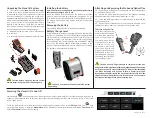
72
of 148
6.1.6 Control via the PLC interface
The PLC interface of the RESISTOMAT
®
2329 was developed in accordance with the DIN EN 61131-2 standard.
The circuitry is designed for a feed voltage of 24 V DC -15 % / +20 %. The PLC outputs of the 2329 were
developed for current-consuming PLC inputs. The 2329 has current-consuming PLC inputs.
The logic system is positive. The low level is -3 V to +5 V, the high level is +15 V to +30 V.
If high-impedance inputs are connected to the PLC outputs of the 2329, a resistor might need to be connected
to ground to prevent the output leakage current (Low < 0,2 mA) from giving rise to undesirable high levels.
Be careful that the leakage current at the ext. pull down resistor gives a voltage less than 5 V because only a
voltage up to 5 V is for the PLC "Low".
A prerequisite for use of the PLC interface is the connection of an external DC power supply to the 37 pole
D-Sub socket (“+” to 18 or 19 and “-” to 20). The PLC interface is isolated from all internal circuit components
by means of optocouplers. The voltage between protective earth (PE) and “-” must not exceed 30 V.
Available inputs:
l
Start / stop measurement
l
Start / stop (reset) comparator
l
Start / stop datalogger
l
Start / stop max. / min.
l
Start / stop printer
l
Transfer of device settings
l
5 inputs for binary selection of the device settings (e.g. input 0 = 2
0
)
l
4 inputs which can be read out via the interface (only with the measurement stopped).
Available outputs:
l
End of measurement
l
Previous measurement faulty
l
Measurement in progress
l
Output for evaluation (comparator)
>> or > with 2 limiting values
l
Output for evaluation (comparator)
>
l
Output for evaluation (comparator)
=
l
Output for evaluation (comparator)
<
l
Output for evaluation (comparator)
<< or < with 2 limiting values
l
3 outputs which can be controlled via the interface (only with the measurement stopped).
The device is also equipped with 2 terminals for starting and stopping measurements, as well as 5 relay contacts
(NO) with a common root on this socket.
Measurements can be triggered by closing a simple mechanical contact (e.g. footswitch). This contact should
have a low bounce factor. Renewed closure (after opening) stops the measurement or, in the case of a single
measurement, starts one again after the measurement time has elapsed.
The relays allow easy evaluation with the comparator function if only a few measurements need to be performed.
Caution: In the continuous mode, proper operation of the relays cannot be guaranteed beyond the specified
number of cycles. If many measurements need to be performed, the PLC evaluation output
must
be used.
If PLC-control is involved, manual range selection and single measurements are usually necessary, as only
this can ensure reliable operation. This is because if an error occurs in the automatic range selection mode,
other measuring ranges need to be checked before the cause of the error can be determined. In such cases,
the time-pulse of the system can often be exceeded (measuring time
=
(number of measuring ranges to be
checked) * single measurement time).
In the continuous measurement mode, the results obtained with an active comparator or datalogger cannot
be assigned to an individual test object, thus leading to diffuse statistics.
NOTICE
Before commencing a measurement, ensure that proper bonding has taken place.
The measurement starts just a few microseconds after reception of the command.
















































